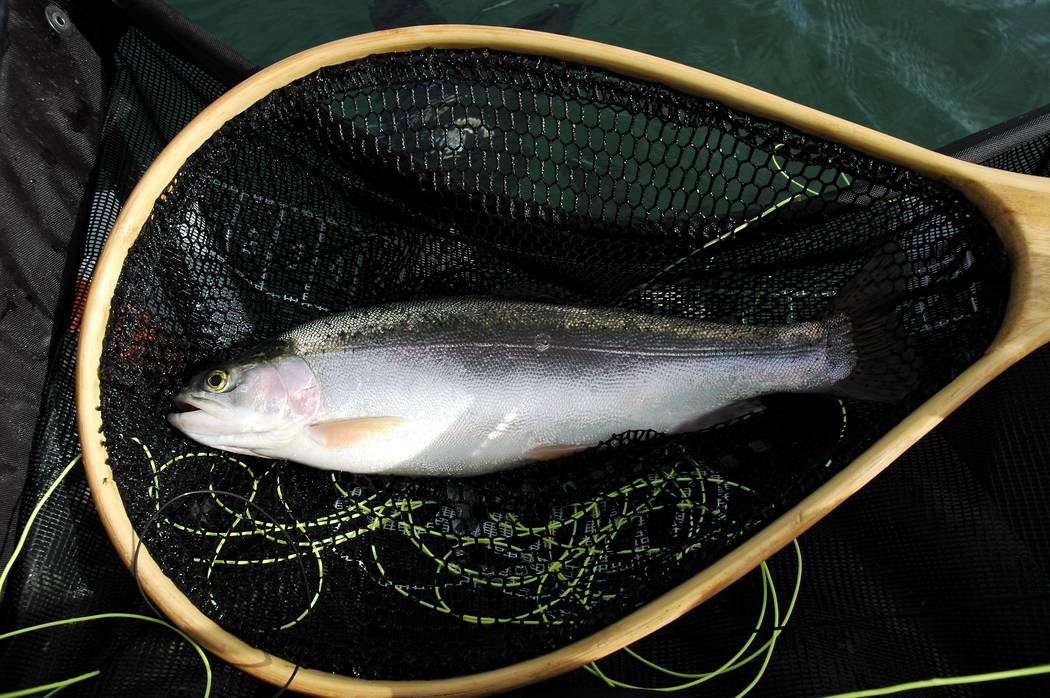Trout action heats up early with Nevada’s mild winter

During a typical winter, mid-February would still be a little soon for any serious talk about early spring trout fishing, but this winter has been anything but typical.
Reservoirs that normally provide excellent fishing through several inches of hard water never really froze. And if they did, it wasn’t for very long. Due to unseasonably warm temperatures, ice conditions always seemed to be just a little too iffy for ice fishing. Of course, I tend to err on the extreme side of caution.
Reservoirs that generally would be covered with ice in February are already ice free. Unless winter comes back with a vengeance, any skim ice you find at sunrise will most likely melt off by mid-morning.
Some of the best trout fishing of the year takes place in the weeks just after ice-out. The action gets started as open water begins to form along the edges of thawing ice. Fish that have been locked beneath the ice will work those edges in search of two things, oxygenated water and something to eat.
Those edges make it possible for trout to dart into open water and then quickly retreat under the ice, which gives them a sense of security from any dangers that might come from above. The fish will also be holding in a shallow layer of water where they will find the highest concentration of oxygen. If the fish are working those edges, it makes sense that anglers should do the same. Just don’t try to fish from the ice because it won’t be safe. Use a boat or float tube, or fish from the shoreline.
Just after ice-out, trout can be very aggressive feeders and will often hit just about anything that looks edible. This is especially true when the shallows begin to warm under sunny skies. That temperature change will trigger the trout bite. The opposite also is true. An overcast sky can cool things down just as quickly.
Through the years, I have found early season success with Panther Martin and Mepp’s spinners, Super Dupers and a variety of spoons. Some of my friends depend on Rooster Tails.
Worms or commercially prepared baits will work as well. So too will wet flies.
In a typical year, the last waters to freeze over and the first to thaw are found at the Kirch Wildlife Management Area about 200 miles north of Las Vegas. Known simply as Sunnyside among old timers, Kirch is home to four popular fishing reservoirs – Adams-McGill, Cold Springs, Haymeadow and Dacey. Each reservoir offers excellent fishing for rainbow trout, crappies and largemouth bass.
Though it is possible to make a day trip to Kirch, it is just far enough away that an overnight trip is probably the best bet. Overnight camping is permitted, but the facilities are primitive.
East of Kirch, near the town of Pioche, is Echo Canyon Reservoir, centerpiece for a state park of the same name. Early season trout fishing can be quite good. The reservoir also is home to crappies and largemouth bass, but these fish won’t be active until water temperatures warm up considerably.
Camping is available in a 33-site campground on the north side of the reservoir and full hookups are available at a 20-site RV campground on a bluff to the south. Drinking water is available near each campsite, and amenities include flush toilets, showers and a dump station.
About 10 miles northeast of Echo is Eagle Valley Reservoir, a 65-acre impoundment that provides anglers with the opportunity to take three species of trout – rainbows, browns and tigers – as well as largemouth bass. A few crappies also have shown up recently.
Eagle Valley is located within the Spring Valley State Park, which offers 37 campsites in its primary campground. Each site includes a shade ramada with a table and drinking water nearby. Amenities include showers, flush toilets and a boat ramp with a courtesy dock. A primitive campground also is available nearby.
Though these waters are currently ice free, keep in mind that weather conditions can change quickly and go prepared for cold temperatures.
Freelance writer Doug Nielsen is a conservation educator for the Nevada Department of Wildlife. His “In the Outdoors” column, published Thursday, is not affiliated with or endorsed by the NDOW. Any opinions he states in his column are his own. Find him on Facebook at @dougwritesoutdoors. He can be reached at intheoutdoorslv@gmail.com












